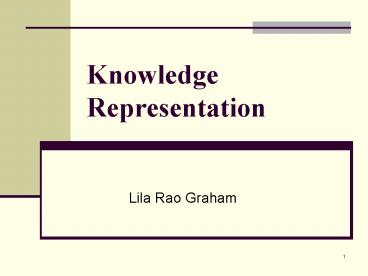Knowledge Representation PowerPoint PPT Presentation
1 / 14
Title: Knowledge Representation
1
Knowledge Representation
Lila Rao Graham
2
Definitions
- Knowledge Base
- A set of representations of facts about the
world. - Each representation is a sentence.
- Knowledge Representation
- Expressing knowledge in a form that can be
manipulated by a computer. - Inference Mechanism
- Generates new sentences that are necessarily true
given that the old sentences are true.
3
- Two aspects of the Knowledge Representation
language - 1. Formal system of defining the world
- Syntax
- What constitutes a sentence
- Semantics
- Meaning. Connects sentences to facts.
- KB entails a (KB a) means when all
- sentences in KB are true, a is true.
- 2. A proof theory
- Rules for determining all entailments.
- (KB -- a)
4
KR Languages
- Logic
- Propositional Logic
- First Order Logic
- Production rules
- Structured Objects
- Semantic Nets
- Frames
5
Propositional Logic Syntax
- A BNF (Backnus-Naur Form) grammar of sentences in
propositional logic. - Sentence ? Atomic Sentence ? Complex Sentence
- AtomicSentence ? True ? False
- ? P ? Q ? R ?
- ComplexSentence ? (Sentence)
- ?Sentence Connective Sentence
- ? ?Sentence
- Connective ? ? ? ? ? ? ? ?
6
Propositional Logic Semantics
Truth table for the five logical connectives
7
Propositional Logic Rules of Inference
- Modus Ponens/Implication-Elimination
- From an implication and the premise of the
implication, you can infer the conclusion - ? ? ?, ?
- ?
- And-Elimination
- From a conjunction you can infer any of the
conjuncts. - ?1 ? ?2 ? ... ? ?n
- ?I
- And-Introduction
- From a list you can infer their conjunction.
- ?1, ?2 , ... , ?n
- ?1 ? ?2 ? ... ? ?n
8
Propositional Logic Rules of Inference
- Or-Introduction
- From a sentence, you can infer its disjunction
with anything else at all. - ?i
- ?1 ? ?2 ? ... ? ?n
- Double-Negation Elimination
- From a doubly negated sentence, you can infer a
positive sentence - ???
- ?
- Unit Resolution
- From a disjunction, if one of the disjuncts is
false, then you can infer the other one is true. - ? ? ?, ? ?
- ?
- Resolution
- This is the most difficult. Because ? cannot be
both true and false, one of the other disjuncts
must be true in one of the premises. Or
equivalently, implication is transitive. - ? ? ?, ? ? ? ? ? ? ? ? ?, ? ? ?
- ? ? ? ?? ? ?
9
Propositional Logic Inference
- Resolution refutation theorem prover
- Inference mechanism for propositional logic
- Refutation
- Recall that S ? is defined as
- Whenever all sentences in S are true, than ? is
true as well. - This is equivalent to saying that
- It impossible for S to be true and ? to be
false. - Or
- It is impossible for S and ?? to be true at the
same time. - In a refutation theorem prover, in order to prove
? from S, add ?? to S and try to derive a
contradiction.
10
- Algorithm to prove S ??
- 1. Rewrite S in clausal form.
- 2. Rewrite ?? in clausal form.
- 3. Using the various inference rules, derive the
empty clause from the results of 1. and 2.
11
Clausal Form or CNF
- Conjunctive Normal Form (CNF).
- Representing a sentence as a conjunction of
disjunctions. - To do this
- 1. Eliminate Implications
- Remember a ? b ? ?a ? b
- 2. Push negation inwards
- ?(a ? b) ? ?a ? ? b
- ?(a ? b) ? ?a ? ? b
- (De Morgans Laws)
- 3. Eliminate double negations
- 4. Push disjunctions into conjunctions
- a ? (b ? c) ? (a ? b) ? (a ? c)
12
Example Converting to CNF
- Converting the following sentence to CNF
- (a ? ? b) ? (c ? d)
- Steps
- 1. Remove Implication
- ?(a ? ? b) ? (c ? d)
- 2. Push Negations Inwards
- ?a ? ? ? b ? (c ? d)
- 3. Eliminate Double Negations
- ?a ? b ? (c ? d)
- 4. Push Disjunctions into Conjunctions
- (?a ? b ? c) ? (?a ? b ? d)
- CNF
- Represented in KB as the 2 clauses
- ?a ? b ? c and ?a ? b ? d
13
Example Resolution
- Prove that r follows from
- (p ? q) ? (r ? s) - (1)
- p ? ? s - (2)
- p ? q - (3)
- Solution
- 1. Clause (1) in CNF
- ? (p ? q) ? (r ? s)
- ?? ? p ? ? q ? r ? s - (1)
- Clause (2)
- ? p ? ? s - (2)
- Clause (3)
- p - (3)
- q - (4)
14
Example (cont)
- 2. Clause of r is ? r - (5)
- 3. Using inference rules
- ?p ? ? q ? s - (6)
- from unit resolution rule of (1) and (5)
- ? q ? s - (7)
- from unit resolution of (3) and (6)
- s - (8)
- from (4) and (7)
- ? p - (9)
- from (2) and (8)
- - (10)
- from (3) and (9)
- Therefore r follows from the original clauses

